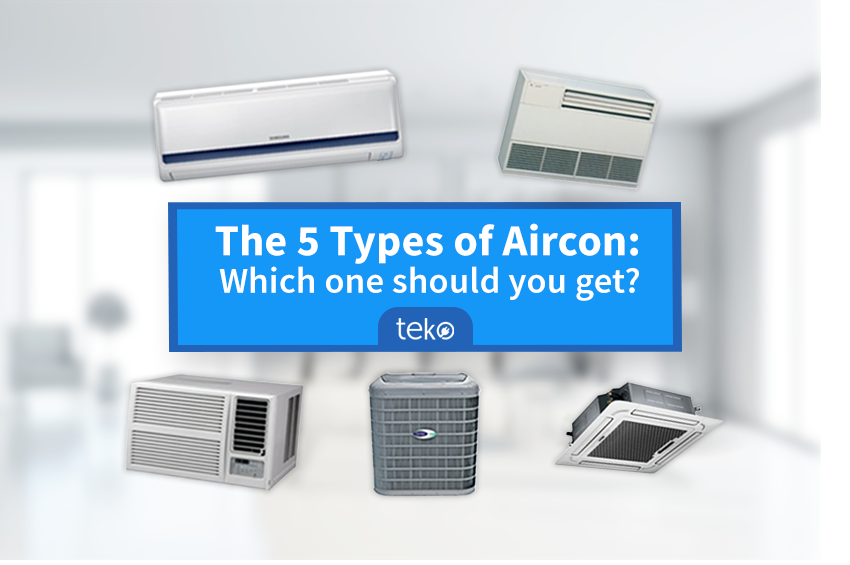
Are you confused with all the aircon options in the Philippines? We’re Teko.ph, the country’s largest aircon and appliance services provider, and we’re here to point you to the right type of aircon!
Although there are various types and brands of air conditioners, picking the one that’s right for you comes down to cost and which model best fits your needs and your space.
1. Central Air Conditioner
This form of air conditioning is ideal if you have a substantially large home and want to chill numerous rooms at once.
The split aspect denotes that the mechanism comprises two primary components. The condenser and compressor are housed outside, while the evaporator coils and air handler are indoors. Like any other air conditioner, central air conditioning uses refrigerant to remove heat from the interior air. Cool air is brought in through the ducts to replace the heat that has been drawn from the inside.
Pros:
- It cools all the areas attached to ducts simultaneously, resulting in a cooler, more controlled climate throughout the house in the shortest amount of time.
- Because cold air is circulated throughout the house, humidity is minimized, making the entire atmosphere more comfortable.
Cons:
- It uses a lot of electricity, which means increased utility costs.
- If an issue occurs in the ducts, the machine may lose efficiency.
- Some people find the outside unit unattractive.
2. Ductless Mini-Split
If you want higher efficiency but don’t want to deal with a lot of ductwork or only want to chill a single portion of your home, mini-split air conditioners are an excellent option.
An air conditioner of this sort is made up of an outside unit with a condenser and a compressor, plus one or more inside components. These indoor units typically are wall-mounted and come with integrated air blowers. The interior and exterior units are linked by tubing, and refrigerant flows differently depending on the kind of consumption.
Because they’re usually compact, each room typically has its own unit, which may be used for either heating or cooling. These air conditioners are considered substantially more energy-efficient than some of the other alternatives available. Still, they can be expensive if you intend on putting one in each room to cover the entire house.
Pros:
- It can be installed in any room without the need for ducting or a lot of effort.
- It can manage the temperature of each room separately.
Cons:
- For big homes, one ductless mini-split unit is insufficient.
- Because it’s wall-mounted, the indoor unit may ruin the room’s interior design.
3. Window Type Air Conditioner
Window types are ideal for cooling a single room or a small area since they come in various sizes. You may even use a single large model of window type air conditioners if you have a single-story or one open room. Since its inception, window type air conditioners have been dubbed “champions of cooling tiny rooms” and are the most common ones sold today.
A window type air conditioner is a single device containing all its components. It breathes cold air into the room from its interior side and unloads heat through its exterior rear. You can easily pull the filter out from the unit for easier cleaning and maintenance. These air conditioners include onboard controls and typically come with remote control.
Pros:
- Window type units are often less expensive to purchase and use.
- They’re easy to set up and maintain.
- They don’t take up too much of your floor space.
Cons:
- They might be noisy and are visible from the exterior of the house.
- They block the view from a window and must be placed near an electrical outlet.
- Some window type air conditioners are not suitable for oddly shaped windows; hence they demand some renovation.
4. Portable Air Conditioner
Window type air conditioners and portable air conditioners are generally similar. They are both typically contained within a single unit with all of its components encased, except that the portable one is a free-standing device that can be transported from room to room. It requires a power source to operate and access a window through which the unit’s air may be vented via a connected tube.
If you need temporary space cooling and installing a window or split type isn’t feasible, consider a portable air conditioner. They’re very handy, and smaller models of this may even be utilized in kennels or restrooms. Single-hose portable air conditioners take air from within a room and exhaust it outside. Alternatively, a dual-hose system sucks air from the outside through one hose, cools the compressor, and then exhausts the air through the other hose.
Pros:
- It can be set up in no time.
- They may be effortlessly moved from room to room and may not be installed permanently.
- For single-space cooling, this is a very practical option.
- When not in use, it is very convenient to store.
Cons:
- During operation, these devices make a lot of noise.
- It might be incapable of cooling larger rooms.
- Portable units with hoses must be positioned near a window, and the hose might obstruct the view.
5. Floor Mounted Air Conditioner
If you want a mini-split but don’t have room for a wall-mounted unit, floor-mounted air conditioners are a great alternative. The indoor component of a floor-mounted air conditioner sits on the floor, while the exterior unit may be placed without any ducting or extensive site preparation. This setup is especially ideal for places with slanted walls, such as attics or structures made of delicate materials like glass.
The unit may be set up 6 inches above the floor and is connected to the outside unit by a tiny hole in the wall. The positioning of this air conditioner makes it very easy to check the air filters for maintenance.
Pros:
- Because of its accessibility, it is ideal for the elderly who live alone.
- Its installation is straightforward.
- It is an excellent alternative for small areas since it takes up very little space.
Cons:
- Impediments such as furniture can hamper airflow in the room.
- Due to the unequal and localized airflow dispersion, it is not ideal for large spaces
Conclusion
And that’s it! As you can see, there are several types of air conditioners available, some for specific purposes and some for general cooling. It’s up to you to define your needs, find the right unit for them, and then decide if you will purchase any type from central air unit to a portable air conditioner.
And if this article didn’t give you the information you needed and you want to learn more, check out the other articles on our website. Our blog about The Best Aircon Brands in the Philippines should be a good place to start! Thinking about opting for a used aircon? Read our quick guide here.
